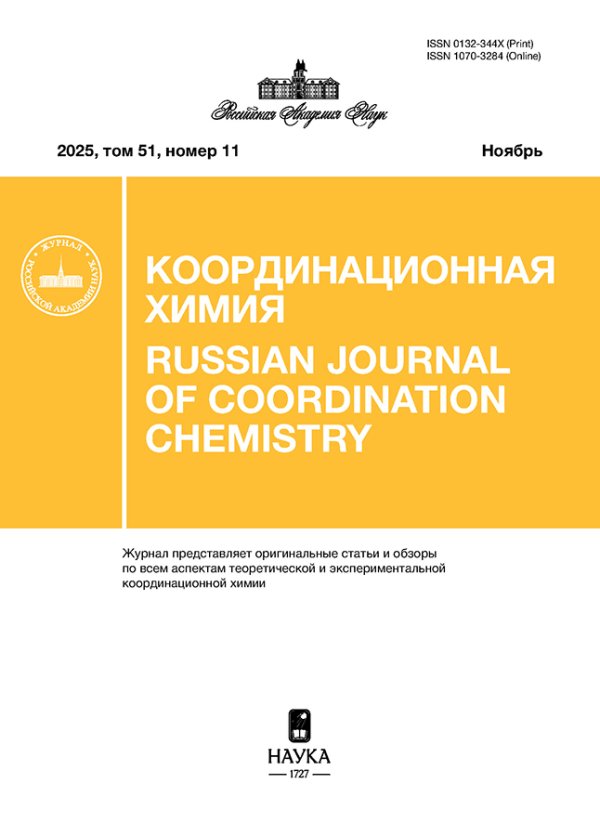Vol 49, No 10 (2023)
Articles
Biologically Active Palladium(II), Zinc(II), and Copper(II) Complexes with Terpene Ligands as Potential Pharmaceutical Drugs
Abstract
A final review of the results of studies of versatile biological activities (in vitro) of chiral metal complexes with benzylamine and ethylenediamine derivatives of terpenes is presented. The cytotoxic profiles of palladacycles containing a Pd–C bond and palladium and zinc chelate complexes were determined. For a number of compounds, the possible mechanisms of potential anticancer action were analyzed, such as modulation of mitochondrial functioning and effect on the parameters of glycolytic function of tumor cells. The antibacterial and antifungal activities of palladium complexes of different types and copper chelate complexes were investigated. A correlation between high antimicrobial activity and antioxidant properties was found for a number of copper complexes. The material is supplemented by an extended analysis of publications in relevant subjects.
 603-623
603-623


Trans-Platinum Complexes with Diclofenac, Aspirin, and 2,6-Di-tert-Butylphenol Fragment: Synthesis and Biological Activity
Abstract
A series of σ-aryl platinum complexes with the sterically hindered phenol group of the general formula RPt[PPh3]2X (R = 3,5-di-tert-butyl-4-hydroxyphenyl; X = Cl (I), diclofenac (II), aspirin (III), and OOCR (IV)) is synthesized and characterized by 1H, 13C, and 31P NMR spectroscopy, IR spectroscopy, and elemental analysis. The molecular structure of compound I is determined by X-ray diffraction (XRD) (CIF file CCDC no. 2243100). The electron and hydrogen atom transfers are studied by spectrophotometry in the CUPRAC and DPPH tests. Complexes I, II, and IV are active reducing agents of Cu(II). The antioxidant activity is studied as the ability of the compounds to inhibit lipoxygenase (LOX-1B). Compound I is found to be an inhibitor of LOX-1B. The antiproliferative properties of the complexes are studied in vitro on the HCT-116, MCF-7, and A-549 cancer cells and WI-38 normal cells. The synthesized compounds have a lower antiproliferative activity than that of cisplatin.
 624-631
624-631


Copper(II) Furancarboxylate Complexes with 5-Nitro-1,10-Phenanthroline as Promising Biological Agents
Abstract
The reaction of copper(II) acetate with 2-furancarboxylic (HFur)/5-nitro-2-furancarboxylic (HNfur) acids and 5-nitro-1,10-phenanthroline (Nphen) in methanol resulted in the formation of the binuclear coordination compounds [Cu2(L)4(Nphen)2]·X (L = Fur (I), Nfur (II); X = H2O (I)), which were structurally studied by direct X-ray diffraction (CCDC no. 2244205 (I) and 2244206 (II)). According to X-ray diffraction data, the coordination environment of the central metal ion in I and II is composed of two nitrogen atoms of Nphen and three oxygen atoms of the acid anions, which thus form the {CuN2O3} tetragonal pyramid in which the copper coordination number is five. Intermolecular hydrogen bonds and stacking interactions between the Nphen aromatic rings provide supramolecular stabilization of I and II. A characteristic feature of supramolecular organization of II is the presence of a coordination bond between the Cu2+ cation and oxygen of the Nphen NO2- group of parallel chains. A biological activity assay for complexes I and II concerning the cytotoxic properties against a human ovarian adenocarcinoma cell line (SKOV3) and the mycobacterial strain Mycolicibacterium smegmatis showed an efficient suppression of cell viability. The results of mathematical modeling of the probability of Cu2+ binding to amino acid residues of M. smegmatis proteins suggested the affinity of the Cu(II) ion to a number of amino acids in polypeptide sites. It was shown that metal ion binding in mycobacterial proteins is more characteristic of histidine- and glutamic acid-containing moieties.
 632-643
632-643


The Search for Domestic Pharmaceutical Substances among Metal Complexes Based on (Hetero)arylamides of 4-Aryl-2-hydroxy-4-oxo-2-butenoic Acids
Abstract
The data obtained on the synthesis and search for biological activity among metal complexes based on 4-aryl-2-hydroxy-4-oxo-2-butenoic acid (hetero)arylamides were integrated. The data on the antimicrobial, anti-inflammatory, analgesic, hypoglycemic, antihypoxic, and immunotropic activities of the synthesized compounds were analyzed. The relationship between the chemical structure and biological activity of chelate complexes was discussed and some regular features were identified. Promising compounds for further research and development of new domestic pharmaceutical substances were found.
 644-650
644-650


Copper(II) and Zinc(II) Complexes with Heterocyclic Acid Anions and 3,5-Dimethylpyrazole: Synthesis, Structure, and Biological Properties
Abstract
The reaction of copper(II) and zinc(II) acetates with 3-furancarboxylic (HFur) and 2-thiophenecarboxylic (HTph) acids with subsequent addition of 3,5-dimethylpyrazole (HDmpz) gave mononuclear complexes [M(L)2(HDmpz)2] (M = Cu(II), L = Fur– (I), Tph– (II); Zn(II), L = Fur– (III)). The structures of compounds I–III were determined by X-ray diffraction. According to X-ray diffraction data, I and II are isostructural: the central Cu(II) atom occurs in a square planar environment formed by two oxygen atoms of carboxylate anions and HDmpz nitrogen atoms; in III, the Zn atom is in the tetrahedral environment of two furoate anions and HDmpz molecules, thus forming the {MO2N2} groups. The complexes are additionally stabilized in the crystal by inter- (I and II) and intramolecular (III) hydrogen bonds. The biological activity of I–III was determined in relation to the non-pathogenic Mycolicibacterium smegmatis.
 651-658
651-658


Interaction of Cobalt Tetrasulfophthalocyanine with ORF8 Accessory Protein of SARS-CoV-2
Abstract
The interaction of cobalt(II) tetrasulfophthalocyanine (CoPc) with the ORF8 accessory protein of SARS-CoV-2 was studied by spectroscopy and calorimetry. The protein was found to shift the aggregation equilibrium in cobalt tetrasulfophthalocyanine solutions towards dimerization. Most probably, the CoPc dimer binds to ORF8 on the greater β-sheet side, thus causing fluorescence quenching. The protein affinity constant to CoPc dimer is 1.5 × 105. Differential scanning calorimetry data indicate that ORF8 undergoes thermally induced denaturation in the temperature range of 38–67°C. Melting of ORF8 includes two stages, which partly overlap. The complex formation of ORF8 with CoPc leads to thermal stabilization of the protein, thus preventing the second stage of protein unfolding. Denaturation of the complex proceeds between 40 and 77°C as two temperature-separated stages. According to gel electrophoresis and immunoblotting data, visible light photoirradiation of the ORF8 complex with CoPc does not induce photooxidation of the protein. It was shown that water-soluble cobalt sulfo-substituted phthalocyanine can be considered as a potential drug inhibiting the ORF8 accessory protein.
 659-664
659-664












